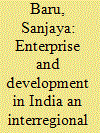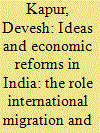|
|
|
Sort Order |
|
|
|
Items / Page
|
|
|
|
|
|
|
| Srl | Item |
| 1 |
ID:
058937


|
|
|
|
|
| Publication |
Oct 2004.
|
| Summary/Abstract |
India over the past century has been characterized by sharp inter-regional variation, with western, north-western and southern India recording higher rates of growth than eastern, central, north-central and north-eastern India. Explanations for this have focused on regional variations in the agrarian economy dating to the colonial period. After independence, planning and fiscal policy were deployed to rectify regional disparities, but have not fared well. During the 1990s, while some middle-income states have been able to improve their position, the backward regions have yet to move to a higher growth trajectory. This paper argues that public investment can, in fact, accelerate economic development in backward regions, but only when the pre-conditions for private enterprise development already exist. Regions that have not made the transition to agrarian capitalism are unlikely to urbanize and industrialize. Worse, a century of backwardness can engender inertia and despair. This remains an important challenge for the future of India’s economic reforms.
|
|
|
|
|
|
|
|
|
|
|
|
|
|
|
|
| 2 |
ID:
058934


|
|
|
|
|
| Publication |
Oct 2004.
|
| Summary/Abstract |
Since 1990, India’s equity markets have been transformed from archaic institutions to, in some respects, exemplars of global best practice. This essay investigates the role of financial globalization in shaping these changes. It examines the economic incentives created by the growth of international capital flows, the political leverage of international financial institutions, and the impact of international norms. It argues that international capital flows created relentless incentives for reform, but also that these incentives do not dictate specific policy responses. International norms played an important role both in offering models for specific reforms and in shifting the rhetorical field of policy discourse in favor of the reformers.
|
|
|
|
|
|
|
|
|
|
|
|
|
|
|
|
| 3 |
ID:
058938


|
|
|
|
|
| Publication |
Oct 2004.
|
| Summary/Abstract |
India's class structure has changed substantially between the pre-1980 and post-1980 periods. During 1950-80, there were essentially two main groups: a tiny elite and large impoverished mass. A more differentiated and complex pattern – in which the elite and mass components were supplemented with a substantial middle class – characterized the 1980-2004 period. The paper argues that this layered and sectorally differentiated middle class has a complicated relationship with economic liberalization. Despite popular impressions, the middle class remains dominated by public-sector employees and state-subsidized farmers seeking to derive the benefits (but avoid the costs) of liberalization. This tension, combined with the growth and rising self-confidence of the middle class, is part of the explanation for the sustained but gradual liberalization since 1991. The paper also briefly examines the complex relationship between the upper-caste-dominated middle class and the growth of the BJP during this period.
|
|
|
|
|
|
|
|
|
|
|
|
|
|
|
|
| 4 |
ID:
058936


|
|
|
|
|
| Publication |
Oct 2004.
|
| Summary/Abstract |
Discussions on the economic effects of globalization focus primarily on the causes and consequences of the increased cross-border flow of capital, goods and services. This paper highlights a more subtle mechanism arising from the cross-border flow of human capital – namely, the flow of ideas. Transmitted directly by policy intellectuals who returned to India after working or studying outside India, as well by members of the Indian diaspora that have settled abroad, these ideas have influenced India’s policy framework. Many of these elites are embedded in international "epistemic communities" that have become linked to India’s policymaking process. Patterns of elite migration, combined with certain features of India’s policymaking process and institutional environment, have reshaped the economic preferences of elites, with significant consequences for the trajectory of economic reforms. This is a dynamic that is as likely to increase as to abate as the reform process continues.
|
|
|
|
|
|
|
|
|
|
|
|
|
|
|
|
| 5 |
ID:
058935


|
|
|
|
|
| Publication |
Oct 2004.
|
| Summary/Abstract |
This paper advances three inter-linked arguments about the NDA government’s performance on labor reform. First, like its predecessors, the NDA government has continued to “reform by stealth,” facilitating backdoor policy changes rather than effecting them through overt decision-making. This has involved, among other things, relying on state-level leaders in India’s federal system to negotiate awkward political dilemmas. Second, though the NDA avoided directly reforming core labor legislation, it nevertheless helped to nudge labor reform from the narrow confines of elite politics onto the terrain of mass politics – an important aspect of the transition from first- to second-generation reform. Third, on the other key indicator of this transition – the building (or resuscitation) of institutions – there has been little progress. Indeed, the institutions necessary to manage the transition to a new labor-relations regime have been actively undermined, not least as a result of the Machiavellian politics involved in the process of reforming by stealth
|
|
|
|
|
|
|
|
|
|
|
|
|
|
|
|
| 6 |
ID:
058933


|
|
|
|
|
| Publication |
Oct 2004.
|
| Summary/Abstract |
This essay compares institutional reform in two key infrastructure sectors: telecommunications and power. While reform in India’s telecom sector was relatively successful, the power sector fared much less well. Why? To be sure, reforming power tariffs presented more political obstacles than did regulating telecom pricing, but this does not fully explain the divergent outcomes in the two sectors. This paper argues that successful reform in the telecom sector resulted from its reliance on a “homegrown” approach, itself inspired by ideational changes within the prime minister’s office. This helped reformers to devise reforms that would attract private-sector investment. The power sector depended on World Bank ideas to a much greater extent, making it difficult to instill regulatory confidence among private-sector actors. The other key variable explaining the differing outcomes was institutional: whereas India’s constitution confers responsibility for the power sector to state governments – indeed, state-level regulators were established alongside their central government counterpart – telecommunications is almost entirely a central government competence. Thus, facing fewer coordination problems, telecommunications was a more conducive sector for institutional reform. The paper concludes by arguing for strengthened, yet accountable, regulators in both sectors.
|
|
|
|
|
|
|
|
|
|
|
|
|
|
|
|
| 7 |
ID:
058932


|
|
|
|
|
| Publication |
Oct 2004.
|
| Summary/Abstract |
This article examines the trajectory of India’s economic reforms – assessing both past trends and future challenges. It argues that the gradual nature of reform has been a reflection of the pluralistic character of India’s politics. Contrary to popular perception, India’s reforms were not imposed by international financial institutions. The paper also takes issue with recent research claiming that, because economic growth in the 1990s was, on average, little better than growth in the 1980s, therefore the reforms of the 1990s cannot be considered a hugely consequential development. The author argues that the higher growth rates of the mid 1990s – of roughly 7.5 percent – could not have been achieved by simply continuing with the very limited liberalization of the 1980s. Moreover, sustaining this higher growth trajectory in the years ahead is feasible if, at a minimum, three issues are addressed: agricultural reform, infrastructural improvement, and reforms to unlock the economic potential of poorly performing regions.
|
|
|
|
|
|
|
|
|
|
|
|
|
|
|
|
|
|
|
|
|